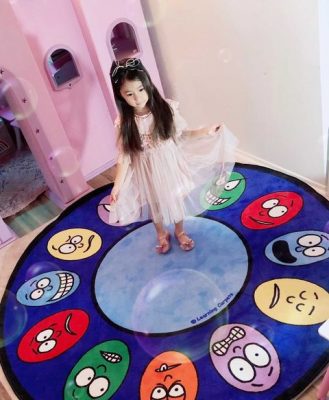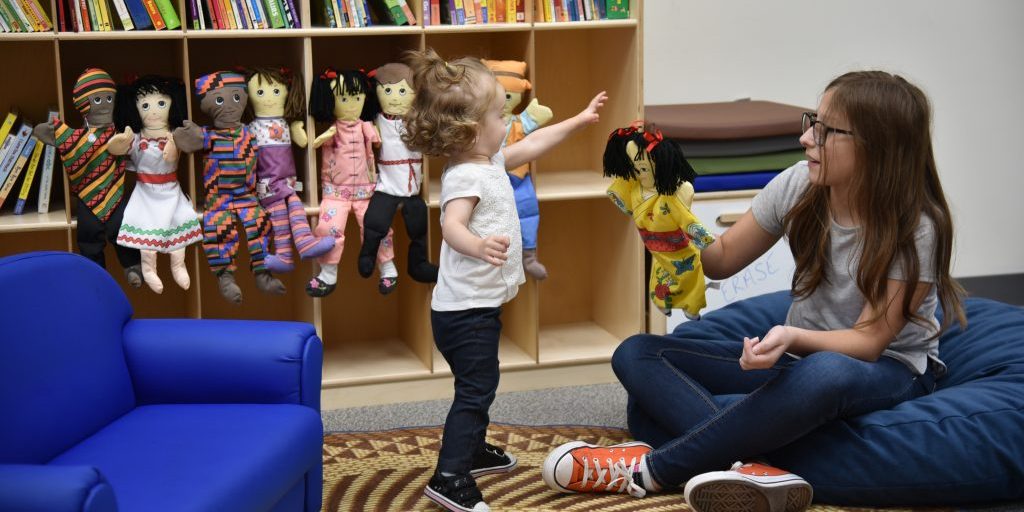
Social Emotional Learning Opportunities in Challenging Times
Have you ever been asked if you see the glass as half-full or half-empty? Regardless of our perception, the glass is actually 100% full. Whether it has air or water in it, there is always something filling the glass. Imagine what we could accomplish if every person on Earth viewed the glass, not just as half full, but as 100% full all the time. The truth is the world has restrictions. We need to find ways to thrive while working within these restrictions until we can go back to the old normal.
Social Emotional Learning and Faces
Part of Social Emotional Learning focuses on facial recognition to discern when others are happy, angry, sad, in pain, confused, etc. There are many activities we can use to teach kids about understanding their own emotions as well as how to identify the emotional state of others. After this first step, then parents, teachers, and caregivers are able to teach children how to be empathetic to another person’s emotional state. These are valuable skills children will use throughout their lives.
Facial expressions are incredibly nuanced. Exposing babies and toddlers to faces and facial expressions is how we train the next generation to identify emotional states and use empathy to deal with their peers, parents, and people they encounter in their future lives. If the average human sleeps 8 hours a day, then the average child must sleep closer to 10 hours a day. Therefore, they have approximately 14 hours a day to experience the world. If a child is in daycare or elementary school for 6-7 hours a day, five days a week, then their opportunities to see faces have just drastically been cut short if everyone is wearing a mask constantly.
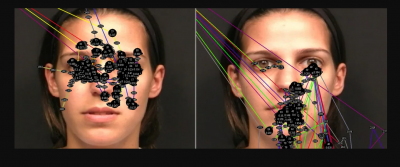
David Lewkowicz/Haskins Labs/Yale University published a study in 2012 where an eye-tracking device was used to capture on video the specific region on a woman’s face where babies focused their gaze when she was talking. It uncovered how babies of differing ages focus on different parts of the face when learning speech and language skills.
The Eyes vs. The Mouth
Dr. David Lewkowicz, a senior scientist at Haskins Laboratories and a professor adjunct at the Yale Child Study Center, has been researching the importance of how children and babies process visual speech information or lipreading long before the COVID pandemic. Lewkowicz’s research led to him co-author a 2012 study where an eye-tracking device was used to capture on video the specific region on a woman’s face where babies focused their gaze when she was talking.
“That first year of life is when speech and language are emerging in a major, major way. What we discovered, in a nutshell, was that at four months of age babies were really interested in the eyes of the talker. But then, at eight months of age, there was a really dramatic shift … where they started to look much more at the mouth region of the person that was talking to them. As they grow, babies use lipreading as part of speech and language development. This means that for infants who are in daycare settings, and therefore constantly seeing masked caregivers, there may be some detrimental effects,” Lewkowicz said in an illuminating CBC News article by Carly Thomas.
Focusing on a Positive Outcome
An in-depth look at Lewkowicz’s thesis reveals children of around 6 months of age begin to engage in babbling and other vocalizations which leads to focusing on the mouth of adults. As infants grow, they begin to exhibit increasingly sophisticated multisensory perceptual abilities. According to Lewkowicz, “humans who are deprived of early visual input exhibit neural and behavioral deficits in multisensory integration. Similarly, children with autism spectrum disorder who tend to pay less attention to people’s faces during early development exhibit audiovisual speech integration deficits later in childhood.”
The long-term effect of the pandemic is not concrete. We know children adapt to situations more easily than adults. Therefore, knowing we can’t change the past, we should focus on opportunities in the future to ensure a positive outcome.
Remote Learning
Remote learning provides a way for teachers to teach without wearing a mask. Some kids find it more difficult to learn when their teacher’s words are muffled from wearing a mask. This is especially true for hearing impaired children. Additionally, kids who are strong auditory learners might find muffled words are detrimental to their ability to learn more than kids who learn visually or kinesthetically. Therefore, remote learning might seem great if these are the only considerations.
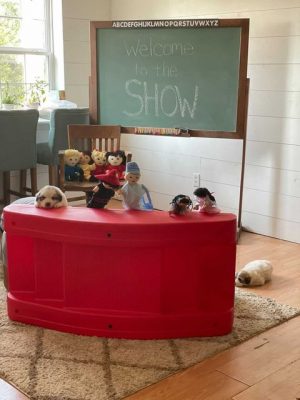
Impromptu Play Dates: These kids made a puppet show theatre out of our Red Rocker/Toddler Bridge. (Available with the rails 3004 or without the rails 1155.) (Career Hand Puppets – Set of 6: CF100-807.)
The Clear Face Mask Option
Full coverage, clear face masks are an amazing alternative to standard face masks where the mouth cannot be seen. They allow children to lipread so speech and language develop unhindered. Clear masks could be the knight in shining armor allowing our kids to go back to learning in live classrooms while providing a level of protection making parents, teachers, and kids all feel safe and secure.
The First Word in Social Emotional Learning is Social
Little ones need to be in the same room with other children to learn how to be social. Sharing, kindness, self-regulation, and other social-emotional functioning can be pivotal to long-term social competence. One study by Damon E. Jones Ph.D., Mark Greenberg Ph.D., and Max Crowley Ph.D. published in the American Journal of Public Health October 9, 2015, found, “statistically significant associations between measured social-emotional skills in kindergarten and key young adult outcomes across multiple domains of education, employment, criminal activity, substance use, and mental health.” This study reinforces the importance of the social aspect of school beginning from a young age. (See references for more information.)
If the only option is for your child to engage in remote learning, then here are a few ideas you can implement to make sure their Social Emotional Learning stays on schedule.
-
Schedule Playdates
Now is not the time to lock yourself inside your home. Find a few trusted friends who have kids and set up regular playdates. This way your kids will stay on track learning to share, be kind, etc. It’s an excellent opportunity to work on social emotional learning as well as other skills.
-
Group Remote Learning
Who says each child needs to sit in front of one computer learning by themselves? Why can’t you and other parents decide to have your kids learn together? Maybe you and your kid’s friends go to your house on Mondays, Jenny’s house on Tuesdays, Paul’s house on Wednesdays, etc. Hook the computer up to your digital TV. There is no reason why 5 or 6 kids can’t get in front of one, big screen TV to learn. This allows children to interact on a small scale while learning remotely. The secondary benefit is your work will not suffer. How many of us can oversee our children as they learn every day? If your responsibility in this area is cut down to once a week, then you might be able to make it manageable while still maintaining a high-functioning work environment.
15 Social Emotional Learning Activities
- Paper Plate Emotion Masks: Cut paper plates in half and glue popsicle sticks to the bottom of the plates to use as handholds. Draw faces on the plate masks to represent 4 different emotional states: happy, sad, angry, and silly. Ask kids to correctly identify the masks. Once they have identified a mask correctly, then allow them to craft their own mask with that emotion before moving on to the next one. Use these masks during storytime. Hold one in front of your face to identify a main character’s emotional state at that point in the story. Briefly discuss how the character was feeling to reinforce each child’s understanding of these emotions.
- Emotion Floor Cushions: Use our Emotion Floor Cushions to play a learning game. Set of 4 cushions: 1 happy face, 1 angry face, 1 sad face, and 1 surprised face.
- Calming Kits: Put together Calming Kits for your kids so they are equipped to handle situations and manage their emotions. Kits can be placed in personalized plastic bins with lids.

CF349-057 Emotion Floor Cushions are easy to tote from space to space and help kids identify emotions.
- Strategy Cards: Download some free card images, punch holes in the corners and place all the cards on a ring. One example: suggest a child think about someone they love.
- Squeeze Balls: These are great stress relievers.
- Learn to Breathe: Your kit might have breathing exercises kids can do to calm down. Or list them on a poster you hang on the wall.
- Bubble Wrap: It’s fun and relaxing to snap the bubbles on small pieces of bubble wrap. (Not appropriate for children of all ages.)
- Feelings Finder Kit: Kids can hang this kit on the wall by their desks. It has a Rainbow Mood Meter, pictures, and 6 cuddly dolls. Everything kids need to discuss, identify, accept, and manage emotions is included.
- Pearl Swirl: Place a calming jar in kits. A pearl swirl is a great way to relax. As kids twist and turn the bottle, the glitter and pearls will swirl, sparkle, and make patterns inside. (Safety Disclaimer: Small objects pose a choking hazard to children under 3 years of age.)
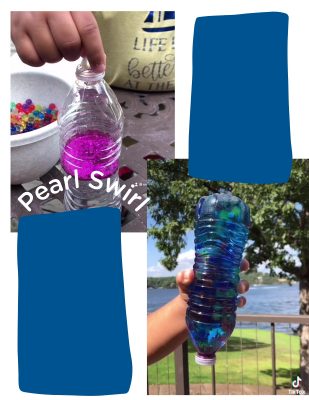
Pearl Swirl ingredients can be purchased individually or bought as part of a calming kit. Either way, it’s a great stress-relieving activity for kids.
- Grow Plants: Plants can have a calming effect on kids and adults. Teach kids to speak kind words to the plants to help them grow. Plants also produce oxygen, which means humans have a symbiotic relationship with plants. It gives teachers and caregivers the perfect opportunity to talk to kids about STEM ideas.
- Coping Strategies Poster: Make one with 4 simple strategies: A) Say, “Would you please stop?” B) Ignore their behavior. C) Walk away. D) Get help.
- Bounce it Out: Place a mini trampoline in the corner of the room and have kids bounce for a minute to reduce stress. (Trampolines are not appropriate for kids of all ages.)
- Stretch for Relaxation: Make a poster showing kids 15 stretching exercises they can do to relieve stress. Stretching is a great way to work on gross motor skills such as balance. It also helps the body intake more air, improves flexibility, and can prevent injury.
- Monster Matching Game: These free downloadable Monsters will make it fun for toddlers and kids to match the cards while learning to identify emotions.
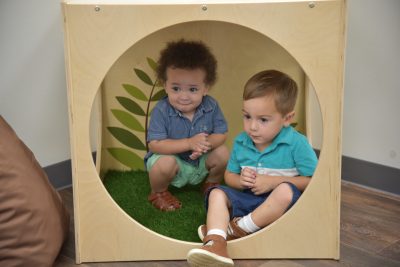
The Nature Reading Cube brings the calming influence of Mother Nature indoors. The artificial grass floor mat is included and acts as a sensory element for kids who need to relax. (ANG1535P)
- Get Back to Nature: Allow kids to sit in the Nature Reading Cube for a few minutes while they use those squeeze balls or pearl swirl jars. Nature has been proven to have a powerful effect on kids. The Nature Reading Cube has an artificial turf floor mat that doubles as a sensory element. It also features a fun nature scene printed on the wood inside the cube using eco-friendly, LED-UV curing, inkjet technology. (ANG1535P)
Safety First
Arts and crafts activities are not appropriate for children of all ages. Small parts and pieces pose a choking hazard to children under 3 years of age. Adult supervision is required at all times during projects.
Amazon Links
Red Rocker/Toddler Bridge with Rails
9″ Career Hand Puppets – Set of 6
Expressions Carpet Round Large
Expressions Carpet Round Small
References:
Lewkowicz, David J. Hansen-Tift, Amy M. “Infants deploy selective attention to the mouth of a talking face when learning speech”. PNAS (Proceedings of the National Academy of Sciences of the Unites States of America.) 31 Jan. 2012. https://www.pnas.org/content/109/5/1431
Thomas, Carly. “How masks could affect speech and language development in children.” CBC News. 17 Mar. 2021. https://www.cbc.ca/news/science/children-masks-language-speech-faces-1.5948037
Jones, Damon E. Greenberg, Mark. Crowley, Max. “Early Social-Emotional Functioning and Public Health: The Relationship Between Kindergarten Social Competence and Future Wellness.” American Journal of Public Health. 9 Oct. 2015. https://ajph.aphapublications.org/doi/full/10.2105/AJPH.2015.302630
